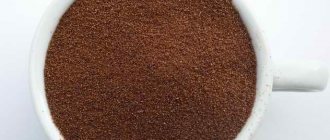What is caffeine?
Caffeine is found in some plants, nuts, seeds, and manufacturers add it to some foods and drinks.
Caffeine has a range of effects on the body, suppressing appetite and making you feel more alert.
Caffeine is a stimulant and speeds up certain processes in the body. Heart rate and breathing may speed up after consuming caffeine. Most effects are short-term and do not cause long-term harm. But if a person consumes large amounts of caffeine, it can have harmful effects on the body.
How likely is a caffeine overdose?
Caffeine overdose is not life-threatening. Caffeine begins to affect the body when there is more than 15 milligrams per liter (mg/L) in the blood. Concentrations between 80 and 100 mg/l can be fatal.
Caffeine overdose is more likely to result from taking dietary supplements or caffeine pills rather than from drinking coffee. This risk is due to the fact that many of these supplements contain higher levels of caffeine than regular foods and drinks.
Unlike coffee or even taking caffeine supplements, using purified caffeine powder is extremely dangerous. A teaspoon of powdered caffeine can be equivalent to 28 cups of coffee. Highly concentrated caffeine products can have serious health effects. The cause of death from caffeine overdose is usually ventricular fibrillation.
What is ppm?
Promille is a thousandth part of the content of one substance in another. 1 ppm of alcohol means that in 1 liter of blood there is 1 ml of pure alcohol, which is stronger than undiluted ethyl alcohol. A half-liter bottle of vodka contains 200 ml of pure alcohol (2.5 ppm). If you consume a liter or more of vodka in a short time, the person will die. As a rule, the body’s protective functions will react to such aggressive bullying by self-cleaning (vomiting).
| ppm | Average characteristics of behavior |
| 0,1 – 0,29 | adequate behavior, the effects of alcohol can only be detected by special tests |
| 0,3 – 0,59 | the person experiences mild euphoria, becomes talkative and inattentive |
| 0,6 – 0,9 | the ability to think sensibly and adequately perceive current events disappears |
| 1 – 1,9 | the person is disoriented, may be aggressive, loses control over the situation |
| 2 – 2,9 | memory impairment and loss of consciousness |
| 3 – 3,9 | loss of consciousness and depression of the nervous system |
| 4 — 5 | loss of consciousness and likelihood of death |
| More than 5 | death |
By the way, the fatal rate in ppm will depend on body weight and level of health. If the drinker is light in weight, this figure decreases significantly in the same way as for patients with chronic diseases:
- of cardio-vascular system
- gastrointestinal tract
- genitourinary system
The volume of the final dose of alcohol is also influenced by gender. Women tolerate large amounts of alcoholic beverages much worse. This is due to the peculiarity of ethanol to linger in fatty tissues, which are more abundant in the female body than in men. In addition, the female liver produces fewer enzymes that break down alcohol, which must be taken into account when drinking. This arrangement of the body gave rise to fables about female alcoholism and its incurability. In fact, addiction does not disappear for either one or the other. If it appears, then for life. The only way to avoid the consequences of alcoholism is through cleansing and complete abstinence. These problems are solved by specialists in rehabilitation centers.
If we return to the conversation about the lethal dose, then many were probably surprised that a person can die from just a liter of vodka. Many alcoholics will be able to drink it and nothing will happen to them. This is true. For such a person to die from alcohol, more serious amounts are needed. There is no magic here, it’s just that the body of an avid drunkard degrades over time, and each time it accepts ethyl alcohol more and more tolerantly. Here the lethal outcome will not be immediate; rather, alcoholism kills them slowly.
Regarding low-alcohol drinks, it should be noted that when drinking them, the “last straw” also exists. But due to the weak concentration of ethyl alcohol, it is physically impossible to drink a destructive amount in a short time. But don’t forget – we are talking about certified drinks. If we talk about counterfeit goods, you can die from a small volume.
Symptoms of caffeine overdose
Typical side effects of caffeine may include:
- feeling wakeful or anxious;
- feeling of restlessness and irritability;
- increased body temperature;
- rapid breathing;
- frequent pulse.
Symptoms of caffeine overdose may include:
- very fast or irregular heartbeat;
- nausea or vomiting;
- staggering.
If a person experiences symptoms of a caffeine overdose, they should seek medical help.
Caffeine during pregnancy and lactation
The fetus and newborn cannot break down caffeine quickly. Gynecologists advise pregnant women to limit their caffeine intake to 200 mg per day, which is equivalent to 1-2 cups of coffee. A number of studies show that drinking coffee during pregnancy increases the risk of obesity in children. Women who are breastfeeding can consume 300 mg of caffeine per day, which is 2 to 3 cups of coffee. However, it is necessary to reduce caffeine intake if the child becomes restless and irritable.
Correct doses of caffeine - for athletes and amateurs
A safe dose of caffeine depends on your health condition. Some people drink strong coffee all day long without any harmful consequences, while for others, just a single cup causes their blood pressure to rise, their sleep to be disturbed, headaches, and nerves. True, caffeine-induced nervousness can be mitigated by the amino acid L-theanine, which is found in green tea leaves. Interestingly, similar symptoms are observed in people with caffeine withdrawal. They also yawn, complain of fatigue, runny nose, muscle stiffness, and find it difficult to concentrate. Despite its positive properties, caffeine cannot be considered a completely safe product.
Authoritative organizations such as the European Food Safety Authority (EFSA), the US National Academies of Sciences (NAS) and Health Canada have concluded that healthy adults can safely consume up to 400 mg of caffeine per day . More than 400 mg can be taken on special occasions (for example, during emergency preparation for an exam). This dose will not cause side effects if such force majeure events occur rarely.
Here's an example of which drinks contain a safe daily dose of caffeine:
The effects of caffeination depend on the time of administration. Most people can drink 200 mg of caffeine in one sitting less than 2 hours before intense physical activity. However, even 100 mg can disrupt sleep if you drink coffee or energy drink at night.
Caffeine leaves the body rather slowly, the half-life is about 5 hours, so people who drank strong coffee less than 10 hours ago still have some amount of the alkaloid fermenting in their blood .
Can children have caffeine?
Pediatricians do not recommend that children and adolescents consume caffeine. Energy drinks in particular can contain large amounts of sugar as well as caffeine. Caffeine may have stronger effects in a person who has a medical condition.
Although there is no clear connection between caffeine and heart health, people who are sensitive to caffeine may experience palpitations.
Caffeine affects people differently depending on their overall health, age, weight, and height.
Grape
Grape berries are classified as "true berries" because the wall of the fruit, known as the pericarp, is entirely fleshy. Like blueberries, grapes are rich in antioxidants. It also contains vitamin K, which helps maintain healthy bones and muscles.
In addition to their nutritional value, grapes are good for moisturizing the skin since they are 82% water. Staying hydrated is key to healthy skin. If you don't drink enough water, it can become tight and dry, less elastic and prone to wrinkles.
Sources of caffeine
Caffeine is found in many products. The most obvious are caffeinated drinks such as coffee, tea, cola and energy drinks. Manufacturers also add caffeine to some products, such as candy.
Medicines such as cold and flu tablets also sometimes contain caffeine.
Caffeine supplements are widely available in tablet or powder form. These forms often contain much more caffeine than coffee, and it is difficult for people to measure how much they have taken. Caffeine powder can contain between 3,200 and 6,400 mg of caffeine per teaspoon. Average caffeine content per 100 milliliters of some products:
- Cola - 9.7 mg;
- Green tea - 12.1 mg;
- Milk chocolate – 20 mg
- Black tea - 22.5 mg;
- Energy drink - 32 mg;
- Dark chocolate - 59 mg;
- Black coffee - 74.7 mg;
- White coffee - 86.9 mg;
- Cappuccino - 101.9 mg;
- Espresso - 194 mg.
Effect of caffeine on the body
Adenosine receptors in the brain are responsible for suppressing excitation. The ability to block adenosine receptors is the main property of caffeine (the caffeine molecule is similar to adenosine), which determines its invigorating effect. In turn, the breakdown of glycogen under the influence of caffeine molecules helps to release additional energy by raising blood sugar levels. In addition, caffeine also increases the concentration of leptin in the blood, which reduces appetite and increases energy expenditure.
The invigorating effect of caffeine directly depends on its amount. Small doses of caffeine are found in tea (up to 45 mg per cup) and instant coffee (up to 70 mg per serving); roasted beans are more saturated with caffeine (up to 115 mg per serving). Separately, it is worth noting energy drinks, the caffeine content of which can reach 250 mg per can. Thus, excessive consumption of energy drinks poses an increased risk of developing cardiovascular diseases, gastrointestinal diseases, and in some cases leads to premature death (cardiac arrest).
Relatively safe dosage of caffeine
Russian regulatory authorities have established a recommendation for daily caffeine consumption. A relatively safe dosage in our country is considered to be the total number of caffeine-containing drinks consumed, not exceeding a total daily dosage of 150–300 mg of caffeine: in terms of cups of tea - no more than 5, per serving of coffee - no more than 3. In the European Union, the EFSA has established a maximum The permissible daily dosage of caffeine is 400 mg, and the maximum single dose is 200 mg.
The effect of caffeine on the female body
The female body is most sensitive to caffeine overdose. Against the background of coffee and energy drink abuse, women have an increased risk of developing breast cancer and osteoporosis, and during pregnancy, a decrease in blood flow to the placenta, increased heart rate in the fetus, premature birth and miscarriage.
Regularly exceeding the recommended dosage inevitably leads to caffeine overdose, the risk of somatic and mental illnesses, and in some cases, psychological dependence on caffeine.
Share
Share
Treatment of caffeine overdose
The half-life of caffeine is 3 to 5 hours. The half-life of a drug is how long it takes for half the drug to be eliminated from the body.
A person may experience side effects that are unpleasant but not cause for concern, such as feeling restless or dehydrated. These side effects usually go away within 3 to 5 hours.
For mild side effects, a person can take the following steps:
- no more caffeine;
- drink more water;
- take a walk to use up energy.
Severe caffeine overdose may require medical treatment, including intravenous fluids or activated charcoal. Activated charcoal may stop the absorption of caffeine in the intestines.
When is caffeine safe?
For most people, a safe daily dose of caffeine is 300 mg
.
This is the equivalent of three small cups of strong coffee. However, do not forget that the level of caffeine in different types of tea, coffee and chocolate may vary. In addition, some people have increased sensitivity to caffeine. Already 100 mg
of this substance can cause unpleasant symptoms of an overdose. The lethal dose of caffeine ranges from 10 to 20 g. However, it is quite difficult to die from caffeine abuse. To kill a person weighing about 70 kg in such a sophisticated way, you would need to treat him to 100 cups of coffee at once.










